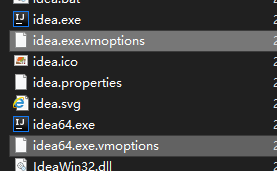Mybatis
maven依赖:
<!-- https://mvnrepository.com/artifact/org.mybatis/mybatis -->
<dependency>
<groupId>org.mybatis</groupId>
<artifactId>mybatis</artifactId>
<version>3.5.2</version>
</dependency>
实现工具类
package com.hu.utils;
import org.apache.ibatis.io.Resources;
import org.apache.ibatis.session.SqlSession;
import org.apache.ibatis.session.SqlSessionFactory;
import org.apache.ibatis.session.SqlSessionFactoryBuilder;
import java.io.IOException;
import java.io.InputStream;
//SqlSessionFactory --->sqlSession
public class MybatisUtils {
private static SqlSessionFactory sqlSessionFactory;
static {
try {
//使用mybatis的第一步
String resource = "mybatis-config.xml";
InputStream inputStream =Resources.getResourceAsStream(resource);;
sqlSessionFactory = new SqlSessionFactoryBuilder().build(inputStream);
} catch (IOException e) {
e.printStackTrace();
}
}
//既然有了 SqlSessionFactory,顾名思义,我们可以从中获得 SqlSession 的实例。
// SqlSession 提供了在数据库执行 SQL 命令所需的所有方法。你可以通过 SqlSession 实例来直接执行已映射的 SQL 语句。
public static SqlSession getSqlSession(){
return sqlSessionFactory.openSession();
}
}
配置文件
<?xml version="1.0" encoding="UTF-8" ?>
<!DOCTYPE configuration
PUBLIC "-//mybatis.org//DTD Config 3.0//EN"
"http://mybatis.org/dtd/mybatis-3-config.dtd">
<!--mybatis-config文件配置-->
<configuration>
<!--引入外部配置文件-->
<properties resource="db.properties"/>
<settings>
<!--标准的日志工厂实现-->
<!-- <setting name="logImpl" value="STDOUT_LOGGING"/>-->
<setting name="logImpl" value="LOG4J"/>
</settings>
<!--实体类别名-->
<typeAliases>
<typeAlias type="com.hu.pojo.User" alias="user"/>
</typeAliases>
<environments default="development">
<environment id="development">
<transactionManager type="JDBC"/>
<dataSource type="POOLED">
<property name="driver" value="${driver}"/>
<property name="url" value="${url}"/>
<property name="username" value="${username}"/>
<property name="password" value="${password}"/>
</dataSource>
</environment>
</environments>
<!--每一个Mapper.xml都需要在Mybatis核心配置文件中注册!!!!!!-->
<mappers>
<!-- <mapper resource="com/hu/dao/UserMapper.xml"/>-->
<mapper class="com.hu.dao.UserMapper"/>
</mappers>
</configuration>
LOG4J
maven:
<!--LOG4J的包-->
<dependency>
<groupId>log4j</groupId>
<artifactId>log4j</artifactId>
<version>1.2.17</version>
</dependency>
log4j.properties
#将等级为DEBUG的日志信息输出到console和file这两个目的地,console和file的定义在下面的代码
log4j.rootLogger=DEBUG,console,file
#控制台输出的相关设置
log4j.appender.console = org.apache.log4j.ConsoleAppender
log4j.appender.console.Target = System.out
log4j.appender.console.Threshold=DEBUG
log4j.appender.console.layout = org.apache.log4j.PatternLayout
log4j.appender.console.layout.ConversionPattern={%c}-%m%n
#文件输出的相关设置
log4j.appender.file = org.apache.log4j.RollingFileAppender
log4j.appender.file.File=./log/kuang.log
log4j.appender.file.MaxFileSize=10mb
log4j.appender.file.Threshold=DEBUG
log4j.appender.file.layout=org.apache.log4j.PatternLayout
log4j.appender.file.layout.ConversionPattern={%p}{%d{yy-MM-dd}}{%c}%m%n
#日志输出级别
log4j.logger.org.mybatis=DEBUG
log4j.logger.java.sql=DEBUG
log4j.logger.java.sql.Statement=DEBUG
log4j.logger.java.sql.ResultSet=DEBUG
log4j.logger.java.sql.PreparedStatement=DEBUG
Spring IOC容器配置(Bean)
<?xml version="1.0" encoding="UTF-8"?>
<beans xmlns="http://www.springframework.org/schema/beans"
xmlns:xsi="http://www.w3.org/2001/XMLSchema-instance"
xsi:schemaLocation="http://www.springframework.org/schema/beans
http://www.springframework.org/schema/beans/spring-beans.xsd">
<!--使用Spring来创建对象,在Spring这些都称为Bean
类型 变量名 = new 类型()
Hello hello = new Hello();
id = 变量名
class = 要new的对象
property 相当于给对象中的一个属性赋值
bean = 对象 new Hello();
-->
<bean id="hello" class="com.hu.pojo.Hello">
<property name="str" value="Spring"/>
</bean>
</beans>
- (1)
id属性是标识单个 bean 定义的字符串。 - (2)
class属性定义 bean 的类型并使用完全限定的类名。
id属性的值是指协作对象。在此示例中未显示用于引用协作对象的 XML。有关更多信息,请参见Dependencies。
Spring注解开发配置
<?xml version="1.0" encoding="UTF-8"?>
<beans xmlns="http://www.springframework.org/schema/beans"
xmlns:xsi="http://www.w3.org/2001/XMLSchema-instance"
xmlns:context="http://www.springframework.org/schema/context"
xsi:schemaLocation="http://www.springframework.org/schema/beans
http://www.springframework.org/schema/beans/spring-beans.xsd
http://www.springframework.org/schema/context
http://www.springframework.org/schema/context/spring-context.xsd">
<context:annotation-config/>
</beans>
常用依赖
<!-- https://mvnrepository.com/artifact/org.springframework/spring-webmvc -->
Spring
<dependency>
<groupId>org.springframework</groupId>
<artifactId>spring-webmvc</artifactId>
<version>5.2.0.RELEASE</version>
</dependency>
测试类
<dependency>
<groupId>junit</groupId>
<artifactId>junit</artifactId>
<version>4.12</version>
<scope>test</scope>
</dependency>
文件未生成解决代码(静态资源导入问题)
<!-- 在build中配置resources,来防止我们资源导出失败的问题-->
<build>
<resources>
<resource>
<directory>src/main/resources</directory>
<includes>
<include>**/*.properties</include>
<include>**/*.xml</include>
</includes>
<filtering>true</filtering>
</resource>
<resource>
<directory>src/main/java</directory>
<includes>
<include>**/*.properties</include>
<include>**/*.xml</include>
</includes>
<filtering>true</filtering>
</resource>
</resources>
</build>
Spring事务配置
<?xml version="1.0" encoding="UTF-8"?>
<beans xmlns="http://www.springframework.org/schema/beans"
xmlns:xsi="http://www.w3.org/2001/XMLSchema-instance"
xmlns:tx="http://www.springframework.org/schema/tx"
xmlns:aop="http://www.springframework.org/schema/aop"
xsi:schemaLocation="http://www.springframework.org/schema/beans
http://www.springframework.org/schema/beans/spring-beans.xsd
http://www.springframework.org/schema/tx
http://www.springframework.org/schema/tx/spring-tx.xsd
http://www.springframework.org/schema/aop
http://www.springframework.org/schema/aop/spring-aop.xsd">
<!--DataSource:使用Spring的数据源替换Mybatis的配置:c3p0 dbcp druid
这里我们使用Spring提供的JDBC:org.springframework.jdbc.datasource
-->
<bean id="dataSource" class="org.springframework.jdbc.datasource.DriverManagerDataSource">
<property name="driverClassName" value="com.mysql.jdbc.Driver"/>
<property name="url" value="jdbc:mysql://localhost:3306/mybatis?useSSL=true&userUnicode=true&characterEncoding=UTF-8"/>
<property name="username" value="root"/>
<property name="password" value="123456"/>
</bean>
<!--sqlSessionFactory-->
<bean id="sqlSessionFactory" class="org.mybatis.spring.SqlSessionFactoryBean">
<property name="dataSource" ref="dataSource" />
<!--绑定Mybatis配置文件-->
<property name="configLocation" value="classpath:mybatis.xml"/>
<property name="mapperLocations" value="classpath:com/hu/mapper/UserMapper.xml"/>
</bean>
<!--SqlSessionTemplate:就是我们使用的sqlSession-->
<bean id="sqlSession" class="org.mybatis.spring.SqlSessionTemplate">
<!--没有Set方法 只能通过构造器注入-->
<constructor-arg index="0" ref="sqlSessionFactory"/>
</bean>
<!--开启事务配置-->
<bean id="transactionManager" class="org.springframework.jdbc.datasource.DataSourceTransactionManager">
<constructor-arg ref="dataSource" />
</bean>
<!--结合AOP经行事务的织入-->
<!--配置事务通知:spring已经做好了-->
<tx:advice id="txAdvice" transaction-manager="transactionManager">
<!--给那些方法配置事务-->
<tx:attributes>
<tx:method name="*" propagation="REQUIRED"/>
</tx:attributes>
</tx:advice>
<aop:config>
<aop:pointcut id="txPointCut" expression="execution(* com.hu.mapper.*.*(..))"/>
<aop:advisor advice-ref="txAdvice" pointcut-ref="txPointCut"/>
</aop:config>
</beans>
SpringMVC配置文件
<?xml version="1.0" encoding="UTF-8"?>
<beans xmlns="http://www.springframework.org/schema/beans"
xmlns:xsi="http://www.w3.org/2001/XMLSchema-instance"
xmlns:context="http://www.springframework.org/schema/context"
xmlns:mvc="http://www.springframework.org/schema/mvc"
xsi:schemaLocation="http://www.springframework.org/schema/beans
http://www.springframework.org/schema/beans/spring-beans.xsd
http://www.springframework.org/schema/context
https://www.springframework.org/schema/context/spring-context.xsd
http://www.springframework.org/schema/mvc
https://www.springframework.org/schema/mvc/spring-mvc.xsd">
<!-- 自动扫描包,让指定包下的注解生效,由IOC容器统一管理 -->
<context:component-scan base-package="com.hu.controller"/>
<!-- 让Spring MVC不处理静态资源 -->
<mvc:default-servlet-handler />
<!--
支持mvc注解驱动
在spring中一般采用@RequestMapping注解来完成映射关系
要想使@RequestMapping注解生效
必须向上下文中注册DefaultAnnotationHandlerMapping
和一个AnnotationMethodHandlerAdapter实例
这两个实例分别在类级别和方法级别处理。
而annotation-driven配置帮助我们自动完成上述两个实例的注入。
-->
<mvc:annotation-driven />
<!-- 视图解析器 -->
<bean class="org.springframework.web.servlet.view.InternalResourceViewResolver"
id="internalResourceViewResolver">
<!-- 前缀 -->
<property name="prefix" value="/WEB-INF/jsp/" />
<!-- 后缀 -->
<property name="suffix" value=".jsp" />
</bean>
</beans>
项目乱码问题解决
修改了xml文件需要重启服务器!
<filter>
<filter-name>encoding</filter-name>
<filter-class>org.springframework.web.filter.CharacterEncodingFilter</filter-class>
<init-param>
<param-name>encoding</param-name>
<param-value>utf-8</param-value>
</init-param>
</filter>
<filter-mapping>
<filter-name>encoding</filter-name>
<url-pattern>/*</url-pattern>
</filter-mapping>
1234567891011121314
注意:这里写/*,写/的话过滤不了jsp页面,不能解决乱码
但是我们发现 , 有些极端情况下.这个过滤器对get的支持不好 .
处理方法 :
-
修改tomcat配置文件 :设置编码!
<Connector URIEncoding="utf-8" port="8080" protocol="HTTP/1.1" connectionTimeout="20000" redirectPort="8443" /> 1234 -
自定义过滤器(万能解决)
package com.kuang.filter; import javax.servlet.*; import javax.servlet.http.HttpServletRequest; import javax.servlet.http.HttpServletRequestWrapper; import javax.servlet.http.HttpServletResponse; import java.io.IOException; import java.io.UnsupportedEncodingException; import java.util.Map; /** * 解决get和post请求 全部乱码的过滤器 */ public class GenericEncodingFilter implements Filter { @Override public void destroy() { } @Override public void doFilter(ServletRequest request, ServletResponse response, FilterChain chain) throws IOException, ServletException { //处理response的字符编码 HttpServletResponse myResponse=(HttpServletResponse) response; myResponse.setContentType("text/html;charset=UTF-8"); // 转型为与协议相关对象 HttpServletRequest httpServletRequest = (HttpServletRequest) request; // 对request包装增强 HttpServletRequest myrequest = new MyRequest(httpServletRequest); chain.doFilter(myrequest, response); } @Override public void init(FilterConfig filterConfig) throws ServletException { } } //自定义request对象,HttpServletRequest的包装类 class MyRequest extends HttpServletRequestWrapper { private HttpServletRequest request; //是否编码的标记 private boolean hasEncode; //定义一个可以传入HttpServletRequest对象的构造函数,以便对其进行装饰 public MyRequest(HttpServletRequest request) { super(request);// super必须写 this.request = request; } // 对需要增强方法 进行覆盖 @Override public Map getParameterMap() { // 先获得请求方式 String method = request.getMethod(); if (method.equalsIgnoreCase("post")) { // post请求 try { // 处理post乱码 request.setCharacterEncoding("utf-8"); return request.getParameterMap(); } catch (UnsupportedEncodingException e) { e.printStackTrace(); } } else if (method.equalsIgnoreCase("get")) { // get请求 Map<String, String[]> parameterMap = request.getParameterMap(); if (!hasEncode) { // 确保get手动编码逻辑只运行一次 for (String parameterName : parameterMap.keySet()) { String[] values = parameterMap.get(parameterName); if (values != null) { for (int i = 0; i < values.length; i++) { try { // 处理get乱码 values[i] = new String(values[i] .getBytes("ISO-8859-1"), "utf-8"); } catch (UnsupportedEncodingException e) { e.printStackTrace(); } } } } hasEncode = true; } return parameterMap; } return super.getParameterMap(); } //取一个值 @Override public String getParameter(String name) { Map<String, String[]> parameterMap = getParameterMap(); String[] values = parameterMap.get(name); if (values == null) { return null; } return values[0]; // 取回参数的第一个值 } //取所有值 @Override public String[] getParameterValues(String name) { Map<String, String[]> parameterMap = getParameterMap(); String[] values = parameterMap.get(name); return values; } } 123456789101112131415161718192021222324252627282930313233343536373839404142434445464748495051525354555657585960616263646566676869707172737475767778798081828384858687888990919293949596979899100101102103104105106107108109一般情况下,SpringMVC默认的乱码处理就已经能够很好的解决了!
然后在web.xml中配置这个过滤器即可!
乱码问题,需要平时多注意,在尽可能能设置编码的地方,都设置为统一编码 UTF-8!
使用Json乱码问题解决
<mvc:annotation-driven>
<mvc:message-converters register-defaults="true">
<bean class="org.springframework.http.converter.StringHttpMessageConverter">
<constructor-arg value="UTF-8"/>
</bean>
<bean class="org.springframework.http.converter.json.MappingJackson2HttpMessageConverter">
<property name="objectMapper">
<bean class="org.springframework.http.converter.json.Jackson2ObjectMapperFactoryBean">
<property name="failOnEmptyBeans" value="false"/>
</bean>
</property>
</bean>
</mvc:message-converters>
</mvc:annotation-driven>
控制台乱码
1.idea设置File Encodings
File -> Settings -> File Encodings下设置编码格式为UTF-8,此种最常见,一般刚装idea或者刚导入项目的时候会遇到此处编码格式未修改的情况。

File -> Settings -> File Encodings
2.修改idea.exe.vmoption
打开idea安装路径bin目录,找到idea.exe.vmoptions与idea64.exe.vmoptions两个文件

image.png
在两个文件的末尾添加一行-Dfile.encoding=UTF-8
[外链图片转存失败,源站可能有防盗链机制,建议将图片保存下来直接上传(img-RVpSd2xo-1628574309940)(https:upload-images.jianshu.io/upload_images/23562935-3b3b58b1f556b69c.png?imageMogr2/auto-orient/strip|imageView2/2/w/426/format/webp)]
image.png
保存后需重启idea。
注意:自作主张去idea的help->Edit Custom VM Options里修改是无效的
3.去项目启动配置中查看是否设置了容器的编码格式
Run->Edit Configration
无论你是直接运行main方法,还是SpringBoot项目的启动方法,还是tomcat,都有一个配置为
VM options,将此配置主动配置为-Dfile.encoding=utf-8,配好重启项目即可。
[外链图片转存失败,源站可能有防盗链机制,建议将图片保存下来直接上传(img-AgM0KPWO-1628574309941)(https:upload-images.jianshu.io/upload_images/23562935-a61a0207d7ee61b4.png?imageMogr2/auto-orient/strip|imageView2/2/w/805/format/webp)]
tomcat

SpringBoot

2.修改idea.exe.vmoption
打开idea安装路径bin目录,找到idea.exe.vmoptions与idea64.exe.vmoptions两个文件
[外链图片转存中…(img-32dWK2FQ-1628574309939)]
image.png
在两个文件的末尾添加一行-Dfile.encoding=UTF-8
[外链图片转存中…(img-RVpSd2xo-1628574309940)]
image.png
保存后需重启idea。
注意:自作主张去idea的help->Edit Custom VM Options里修改是无效的
3.去项目启动配置中查看是否设置了容器的编码格式
Run->Edit Configration
无论你是直接运行main方法,还是SpringBoot项目的启动方法,还是tomcat,都有一个配置为
VM options,将此配置主动配置为-Dfile.encoding=utf-8,配好重启项目即可。
[外链图片转存中…(img-AgM0KPWO-1628574309941)]
tomcat
[外链图片转存中…(img-dXbWEEie-1628574309942)]
SpringBoot
[外链图片转存中…(img-51dgRLOY-1628574309943)]






















 被折叠的 条评论
为什么被折叠?
被折叠的 条评论
为什么被折叠?








